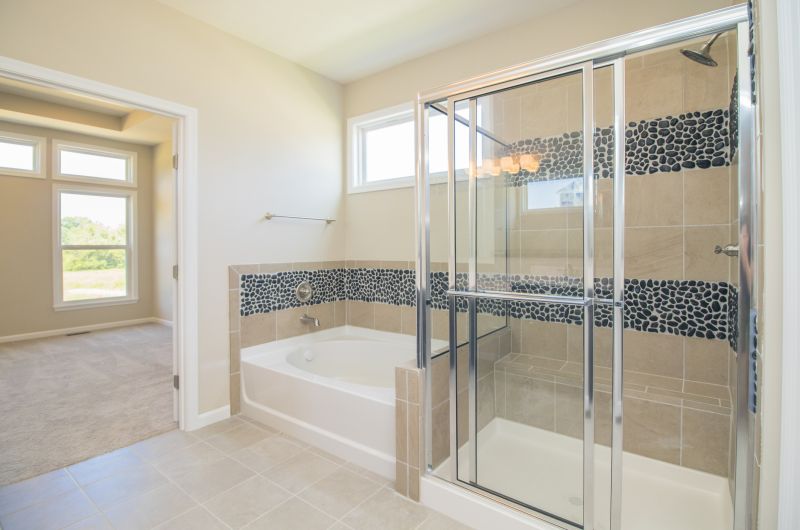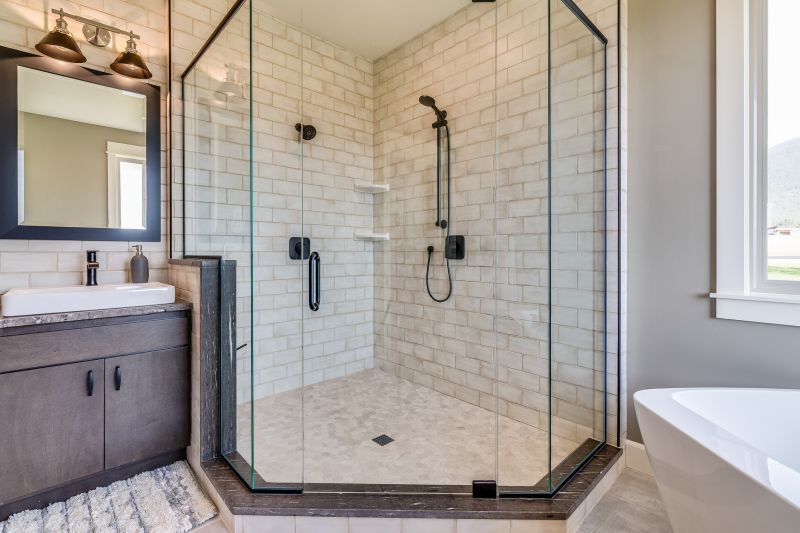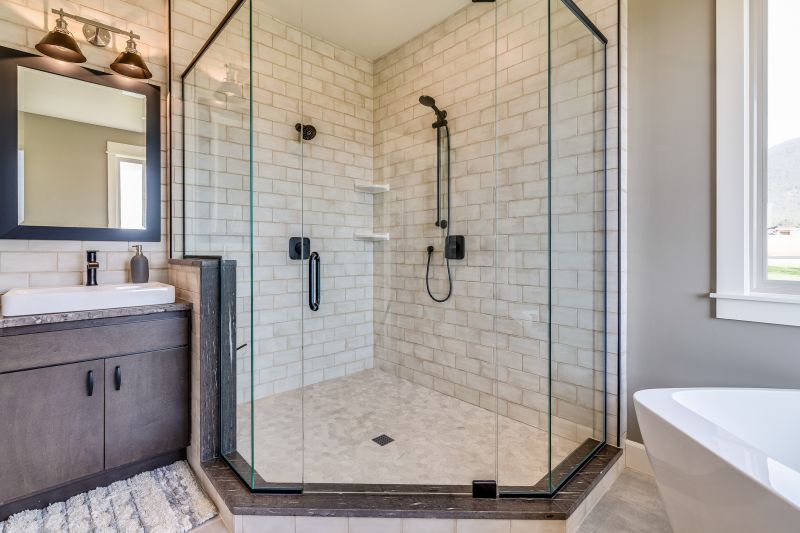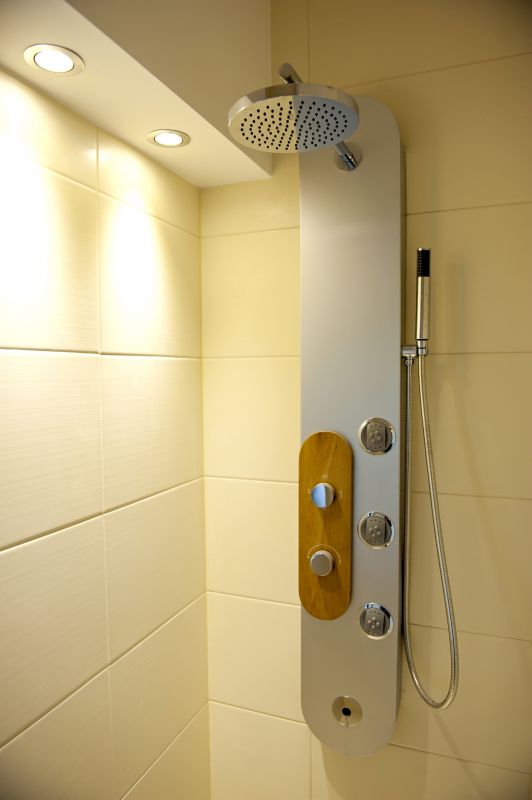Shower Enclosure Layouts
Welcome to Aberdeen Showers
A Side-by-Side Look at Shower Enclosure Layouts Options
Shop for A Side-by-Side Look at Shower Enclosure Layouts

When considering a bathroom renovation, one of the key elements to focus on is the shower enclosure. The layout you choose can significantly impact both the functionality and aesthetics of your bathroom. Homeowners in Aberdeen, North Carolina, have several popular options to consider, each with its own set of advantages and limitations.
One of the most common shower enclosure layouts is the corner shower. This option is ideal for smaller bathrooms where space is at a premium. By utilizing a corner, this layout maximizes the available area while still providing a comfortable showering experience. However, corner showers can sometimes feel cramped and may not be suitable for those who prefer more spacious enclosures.
Another popular choice is the alcove shower layout. This design fits into a three-walled space, often replacing a traditional bathtub. Alcove showers are great for medium-sized bathrooms and can offer a sleek, modern look. The main drawback is the limited flexibility in terms of size and shape, as it must fit within the existing alcove space.
For those with more expansive bathrooms, a walk-in shower layout might be the perfect solution. This design offers an open and airy feel, often featuring glass panels that create a seamless look. Walk-in showers provide ample space and are easy to access, making them a good choice for those with mobility concerns. However, they require more room and can be more expensive to install.
If you're considering a more luxurious option, a wet room layout could be appealing. This design removes barriers entirely, creating a fully waterproofed bathroom space where the shower is integrated into the room itself. Wet rooms are visually striking and offer a high-end feel, but they require extensive waterproofing and may not be suitable for all homes, especially those with limited space.
When selecting a shower enclosure layout, consider the following factors:
- Available space
- Budget constraints
- Desired aesthetic
- Functionality and accessibility needs
- Long-term maintenance considerations
It's essential to balance these factors to find a layout that meets your needs and complements your home's design. Each option offers unique benefits and challenges, so understanding these can help you make an informed decision.
| Option | Pros | Cons | Where it fits |
|---|---|---|---|
| Corner Shower | Space-saving, cost-effective | Can feel cramped | Small bathrooms |
| Alcove Shower | Sleek, utilizes existing space | Limited flexibility | Medium-sized bathrooms |
| Walk-in Shower | Spacious, accessible | Requires more space, higher cost | Large bathrooms |
| Wet Room | Luxurious, open design | Extensive waterproofing needed | High-end renovations |
Ultimately, the choice of shower enclosure layout will depend on your personal preferences, the size and shape of your bathroom, and your renovation budget. By carefully considering these factors, homeowners in Aberdeen can create a bathroom space that is both functional and stylish.
Comparing Shower Enclosure Materials
Shop for Comparing Shower Enclosure
A Detailed Look at Glass, Acrylic, and Tile Options
When planning a bathroom renovation, choosing the right shower enclosure material is crucial for both aesthetics and functionality. Homeowners in Aberdeen, North Carolina, have a variety of materials to consider, each offering unique benefits and drawbacks. This article explores three popular options: glass, acrylic, and tile, providing insights to help make an informed decision.
Glass shower enclosures are a stylish choice, offering a sleek, modern look that can make a bathroom feel more spacious. They are available in various styles, such as frameless, semi-frameless, and framed, each providing a different level of elegance and cost. One of the main advantages of glass is its durability and resistance to mold and mildew. However, glass can be more expensive and may require frequent cleaning to maintain its clarity.

Acrylic is another popular material, known for its affordability and ease of installation. Acrylic shower enclosures are lightweight and available in a wide range of colors and designs, allowing for customization to suit any bathroom decor. While acrylic is less expensive than glass, it is also less durable and can be prone to scratching and discoloration over time. Homeowners looking for a budget-friendly option might find acrylic appealing, though it may need replacement sooner than other materials.
Tile shower enclosures offer a classic and customizable option, with endless possibilities in terms of color, pattern, and texture. Tiles can create a luxurious feel and are highly durable when properly installed. However, they require regular maintenance to prevent grout lines from becoming stained or moldy. Tile installations can also be more labor-intensive and costly, especially if intricate designs are desired.
To summarize, each material has its own set of pros and cons that should be weighed based on personal preferences and budget constraints. Glass offers a modern aesthetic and durability, acrylic provides affordability and ease of installation, and tile allows for extensive customization and a timeless look.
| Option | Pros | Cons |
|---|---|---|
| Glass | Modern look, durable, mold-resistant | Higher cost, frequent cleaning |
| Acrylic | Affordable, easy installation, customizable | Less durable, prone to scratches |
| Tile | Customizable, durable, luxurious feel | High maintenance, costly installation |
- Glass is ideal for modern, spacious bathrooms.
- Acrylic suits budget-conscious renovations.
- Tile is perfect for those seeking a custom, elegant design.
Ultimately, the choice of shower enclosure material will depend on individual needs and the specific layout of the bathroom. By carefully considering the characteristics of glass, acrylic, and tile, homeowners can select the option that best complements their style and meets their practical requirements.
Styles of Shower Enclosures: Frameless, Semi-Frameless, and Framed
Shop for Shower Enclosures: Frameless, Semi-Frameless, and Framed
Understanding the Aesthetic and Functional Differences
When considering a bathroom remodel or new construction in Aberdeen, North Carolina, homeowners often focus on the shower enclosure as a key element. The style of the shower enclosure can significantly influence both the functionality and aesthetic appeal of the bathroom. Three popular styles to consider are frameless, semi-frameless, and framed shower enclosures. Each style offers unique advantages and potential drawbacks, making it crucial to understand their differences before making a decision.
Frameless shower enclosures are characterized by their minimalist design, using thick tempered glass panels that are attached with discreet metal hardware. This style is popular for its modern and sleek appearance, allowing for an open and airy feel in the bathroom. The absence of frames means there are fewer places for water to collect, reducing the risk of mold and mildew. However, frameless enclosures can be more challenging to install and may come at a higher price point.

Semi-frameless shower enclosures offer a middle ground between frameless and framed styles. They feature minimal framing around the outer edges of the glass panels, with the door itself often being frameless. This option provides a balance of aesthetics and practicality, offering a cleaner look than fully framed enclosures while being more affordable than completely frameless ones. Semi-frameless enclosures can suit a variety of bathroom designs and are easier to install than their frameless counterparts.
Framed shower enclosures are the most traditional style, featuring metal frames around all glass edges. They are generally the most budget-friendly option and offer a wide range of design possibilities with different finishes and glass types. The frames provide additional support and stability, which can be beneficial in high-traffic bathrooms. However, the frames can collect water and soap scum, requiring more maintenance to keep clean.
When selecting a shower enclosure style, consider the overall design of the bathroom, the desired level of maintenance, and budget constraints. Each style has its own set of advantages and limitations, making it essential to weigh these factors based on individual needs.
| Option | Pros | Cons |
|---|---|---|
| Frameless | Modern look, less mold risk | Higher cost, complex installation |
| Semi-Frameless | Balanced design, more affordable | Some framing still present |
| Framed | Cost-effective, stable | Higher maintenance, traditional look |
- Frameless: Ideal for modern, high-end bathrooms
- Semi-Frameless: Suitable for versatile, mid-range designs
- Framed: Fits traditional, budget-conscious spaces
Ultimately, choosing the right shower enclosure style involves evaluating the specific needs of the household and the aesthetic goals for the bathroom. By understanding the distinct characteristics of frameless, semi-frameless, and framed enclosures, homeowners in Aberdeen can make informed decisions that enhance both the functionality and beauty of their bathrooms.





